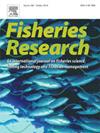Variations in the fish community of the Beibu Gulf (South China Sea) following fishery resources protection measures
IF 2.2
2区 农林科学
Q2 FISHERIES
引用次数: 0
Abstract
The Beibu Gulf is a resource–rich bay in the northwestern South China Sea; however, its fishery resources have been in decline owing to overfishing and other factors. To rebuild the depleted fish stocks, China has implemented a series of fishery resources conservation and management measures; the most influential of these is possibly the summer fishing moratorium, in effect since 1999. This study used data from bottom–trawl surveys conducted in spring and autumn from 1998 to 2020 to analyze variations in the fish community of the Beibu Gulf following implementation of the fishery resources protection measures. The data analysis indicated improvements in fish species richness, diversity, and mean trophic level, but further declines in fish abundance and biomass since 1998. The composition of dominant species, except for the small–sized glowbelly Acropoma japonicum, changed obviously from 1998 to 2020, although still mainly composed of small–sized demersal and pelagic species. Abundance–biomass comparison curves indicate that the disturbance level affecting fish in the Beibu Gulf remained unchanged and that it is still in a heavily disturbed state. These findings suggest that the current fishery resource conservation policies are inadequate for reversing the trend of declining fishery resources. China’s marine fishery resources management measures should be refined by incorporating more–precise conservation measures consistent with the characteristics of the local resources. In particular, relevant measures are needed to control the fishing output, such as the quota fishing system currently being piloted.
渔业资源保护措施对北部湾鱼类群落的影响
北部湾是南海西北部资源丰富的海湾;然而,由于过度捕捞和其他因素,其渔业资源一直在减少。为恢复枯竭的鱼类资源,中国实施了一系列渔业资源养护和管理措施;其中影响最大的可能是自1999年起生效的夏季休渔期。利用1998 - 2020年春季和秋季的底拖网调查数据,分析了北部湾渔业资源保护措施实施后鱼类群落的变化。数据分析表明,自1998年以来,鱼类物种丰富度、多样性和平均营养水平均有所改善,但鱼类丰度和生物量进一步下降。1998 - 2020年,优势种的组成发生了明显的变化,但仍以小型底栖和远洋种为主,除小型光腹acropooma japonicum外。丰度-生物量对比曲线表明,北部湾鱼类受干扰程度保持不变,仍处于严重干扰状态。这些结果表明,目前的渔业资源养护政策不足以扭转渔业资源减少的趋势。完善中国海洋渔业资源管理办法,纳入更加精准的符合当地资源特点的养护措施。特别是需要采取相关措施来控制捕捞产量,例如目前正在试点的配额捕捞制度。
本文章由计算机程序翻译,如有差异,请以英文原文为准。
求助全文
约1分钟内获得全文
求助全文
来源期刊

Fisheries Research
农林科学-渔业
CiteScore
4.50
自引率
16.70%
发文量
294
审稿时长
15 weeks
期刊介绍:
This journal provides an international forum for the publication of papers in the areas of fisheries science, fishing technology, fisheries management and relevant socio-economics. The scope covers fisheries in salt, brackish and freshwater systems, and all aspects of associated ecology, environmental aspects of fisheries, and economics. Both theoretical and practical papers are acceptable, including laboratory and field experimental studies relevant to fisheries. Papers on the conservation of exploitable living resources are welcome. Review and Viewpoint articles are also published. As the specified areas inevitably impinge on and interrelate with each other, the approach of the journal is multidisciplinary, and authors are encouraged to emphasise the relevance of their own work to that of other disciplines. The journal is intended for fisheries scientists, biological oceanographers, gear technologists, economists, managers, administrators, policy makers and legislators.
 求助内容:
求助内容: 应助结果提醒方式:
应助结果提醒方式:


